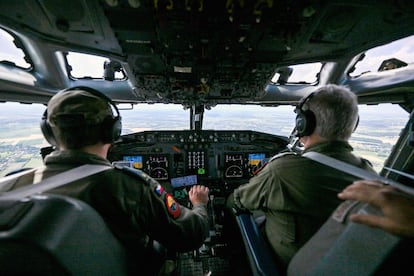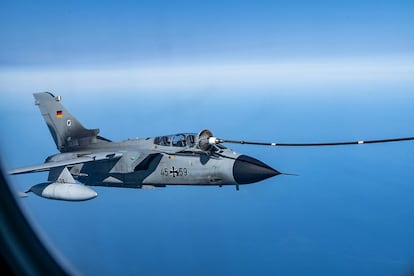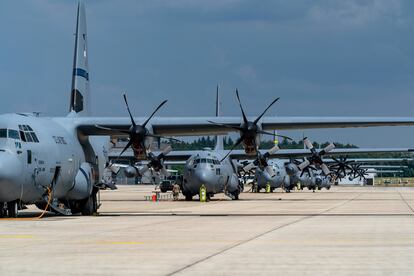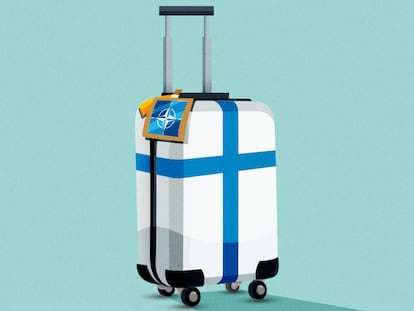NATO shows off its military might in the skies amid growing threat of Russia
The Air Defender 23 exercises were intended as a historic show of force ahead of the organization’s Vilnius summit, which begins on Tuesday

The Eastern military alliance “Occasus” and the special forces of the “Brückner organization” are trying to enter German soil. Having increased their presence around the eastern flank, they prepare to move north and capture the Baltic port of Rostock. In response, NATO activates its Article 5: an attack against one ally is an attack on all. “Occasus” does not exist. Neither does “Brückner,” which is described as a fictitious threat by the German Air Force. It is a simulated crisis that served as the basis for Air Defender 23, the largest air drills in the history of NATO. These drills, led by Germany, have served to highlight the might of NATO’S air forces as it faces the growing threat of Russia.
EL PAÍS witnessed the exercises at the Jagel air base in northern Germany. The drone of fighter jets was deafening as F-16s, A-10s and JAS-39s soared above. Back on the ground, the military teams surrounded the fighter jets and checked that everything was in order. When they received the call to action, they sped down the runway and took off. All in a matter of seconds. The Air Defender 23 exercises, which ended at the end of June, brought together 10,000 soldiers from 25 NATO countries and Sweden. For two weeks, 250 aircraft trained at six German bases, as well as bases in Estonia, Latvia and the Czech Republic.
The Air Defender 23 was a historic demonstration of NATO solidarity. The exercises came at a particularly sensitive moment, as the war in Ukraine drags on and NATO prepares for its Vilnius summit on Tuesday. This summit, which goes until July 12, is set to approve the biggest reorganization of NATO since the Cold War, with a new secret strategy divided by regions, listing Moscow and terrorism as the main threats. The strategy also seeks to reinforce NATO’s air defense; especially on the eastern flank.

It took U.S. Lieutenant Colonel Tater Boudreaux and his partner Tito seven hours to bring the F-16 fighters to Jagel. “We took the long route, the scenic route,” joked Boudreaux, who is a native of New Orleans. It’s not representative of how long it would really take. The exercises were based on a semi-permanent deployment, and it took about a week to move some 400 tons of material to the heart of Europe, including equipment, parts needed by fighter jets and cargo planes, explained a German officer in one of the large tents set up inside the Jagel base, which served as one of the operation centers.
What’s more, as part of the drills, engineers and military operators provided field tank storage with 1.2 miles of pipelines at the Wunstorf air base, the logistics center for the training, explained German Lieutenant Huber during a visit to the site organized by NATO to which this newspaper was invited. During the Cold War, NATO built an oil pipeline to protect its autonomy in the area in case of attack, but this pipeline doesn’t reach Wunstorf.
During the historic exercises, the troops also practiced synchronization, flights and exchanging coded information between allies. They also completed refueling operations that European forces, until very recently, could not carry out without the help of U.S. aircraft.

NATO had been planning the Air Defender 2023 exercises since 2018 — mobilizing 25 allies and planning a schedule is a complex task that can take years. However, Russia’s war in Ukraine, which has shaken the security architecture of the world, provided new impetus for the drills, which also involved the ground-based Griffin Storm exercise in Pabradė, Lithuania.
Under 130 miles from Russia
The Air Defender 2023 exercises were a show of force on the eve of the NATO summit in Vilnius, a symbolic location just under 130 miles from the Russian city of Kaliningrad and 21 miles from Belarus, which is a close ally to Moscow. Russia has been sending troops into Ukraine via Belarus, and the country also offered to host the Wagner mercenary group and its founder Yevgeny Prigozhin after his failed rebellion on June 24.
“Our forces are training together for territorial and alliance defense so that the message will be taken seriously by everyone, that we are ready to defend every centimeter of our territory,” said German Chancellor Olaf Scholz during a visit to the Jagel air base. NATO said that the exercises were not modeled on a specific enemy, but there were similarities with Russia.

Russia has criticized the NATO exercises. “This type of exercise sheds light on the fact that the NATO military machine has nothing to do with defense and that all its efforts are aimed exclusively at completely containing our country and even testing ways to attack Russia,” said a spokesperson from the Russian Foreign Ministry. China — which NATO defined as its “biggest challenge” at the Madrid summit a year ago — stated that the training “exacerbates the geopolitical confrontation in Europe.”
Although planning for the exercises began back in 2018, the drills have helped Germany reaffirm itself as a global security actor. In Germany, the war in Russia has triggered a major turning point — or Zeitenwende in the words of Scholz — with the country set to significantly increase its defense budget. However, the Air Defender exercises also made it clear that NATO’s air defense largely depends on the United States. It is the most powerful member of the 31 countries that make up the alliance: Finland joined in April, and Sweden hopes to join soon.

Protecting the skies
The strategy to protect Europe’s skies has been hotly disputed in Europe since Putin invaded Ukraine last. At the Vilnius summit, NATO is expected to consecrate a new framework for the eastern flank, which will change the air defense model so that there is more active monitoring of Russian military aircraft.
Meanwhile, with Washington watching in the background, the Franco-German axis is in conflict over the best way to protect Europe’s skies. Germany wants to create an anti-missile shield (the Sky Shield), a plan supported by 16 European countries And it is planning to jointly purchase an anti-aircraft defense system — which would be integrated with the NATO system — through American and Israeli technology. Germany argues that it is more pragmatic and quicker to invest in proven solutions. Meanwhile, French President Emmanuel Macron has urged allies to back a more local air defense strategy and consider long-term systems.
The French president, who claims that the EU needs strategic autonomy so that it is not dependent on the U.S. through NATO, said that at least four countries — Belgium, Cyprus, Estonia and Hungary — have signed a letter of intent to jointly purchase the French-made Mistral air defense system. “What Ukraine shows is that we can only give Kyiv what we have and produce. What comes from non-European countries is less manageable. It is subject to timetables, priorities and sometimes even authorizations from third countries,” said Macron.
Sign up for our weekly newsletter to get more English-language news coverage from EL PAÍS USA Edition
Tu suscripción se está usando en otro dispositivo
¿Quieres añadir otro usuario a tu suscripción?
Si continúas leyendo en este dispositivo, no se podrá leer en el otro.
FlechaTu suscripción se está usando en otro dispositivo y solo puedes acceder a EL PAÍS desde un dispositivo a la vez.
Si quieres compartir tu cuenta, cambia tu suscripción a la modalidad Premium, así podrás añadir otro usuario. Cada uno accederá con su propia cuenta de email, lo que os permitirá personalizar vuestra experiencia en EL PAÍS.
¿Tienes una suscripción de empresa? Accede aquí para contratar más cuentas.
En el caso de no saber quién está usando tu cuenta, te recomendamos cambiar tu contraseña aquí.
Si decides continuar compartiendo tu cuenta, este mensaje se mostrará en tu dispositivo y en el de la otra persona que está usando tu cuenta de forma indefinida, afectando a tu experiencia de lectura. Puedes consultar aquí los términos y condiciones de la suscripción digital.
More information
Últimas noticias
Most viewed
- Sinaloa Cartel war is taking its toll on Los Chapitos
- Oona Chaplin: ‘I told James Cameron that I was living in a treehouse and starting a permaculture project with a friend’
- Reinhard Genzel, Nobel laureate in physics: ‘One-minute videos will never give you the truth’
- Why the price of coffee has skyrocketed: from Brazilian plantations to specialty coffee houses
- Silver prices are going crazy: This is what’s fueling the rally











































